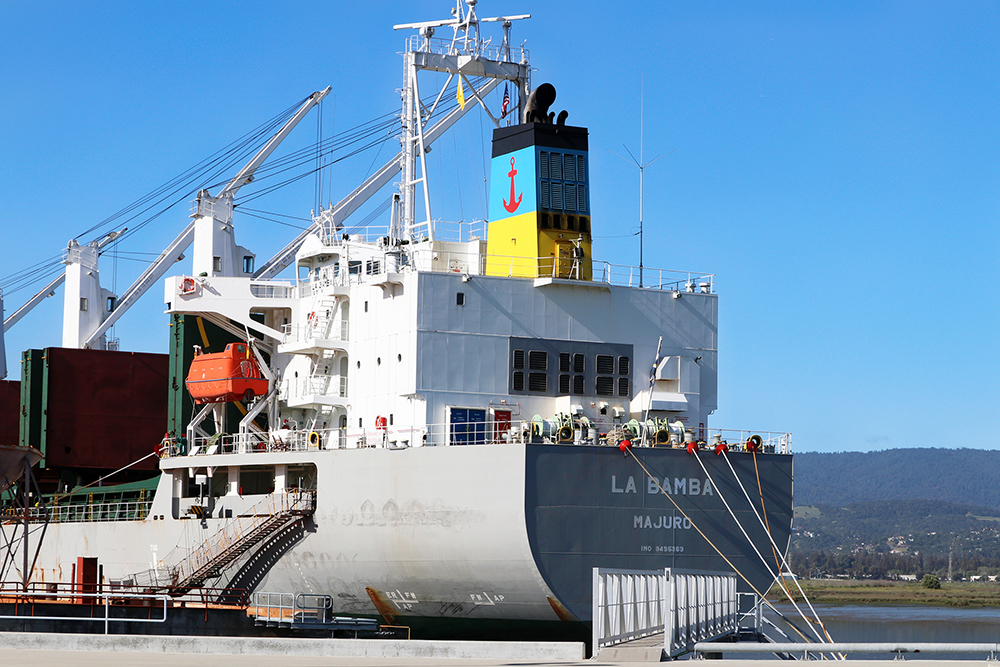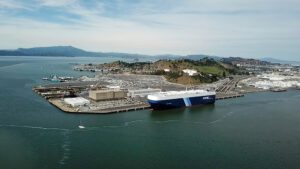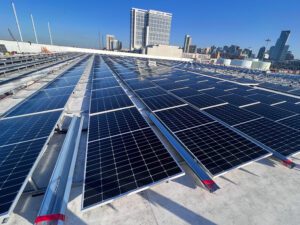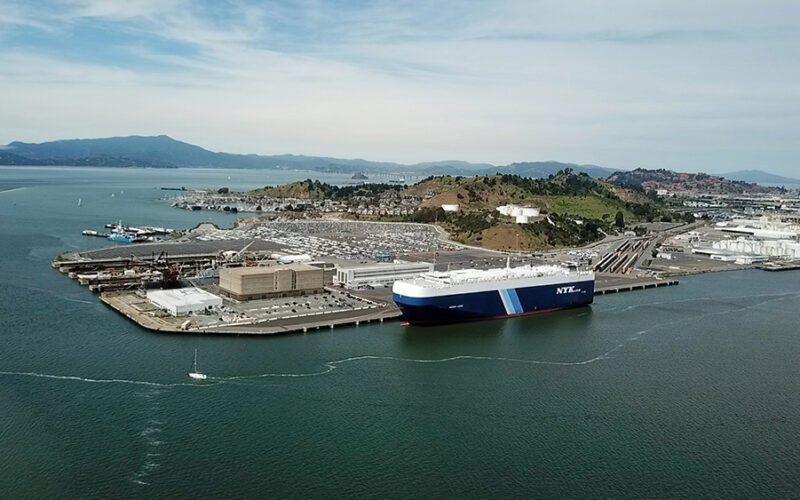
By Sara Hall
Smaller ports in California have some big infrastructure projects in the works. The ports are focusing on increasing cargo capacity, enhancing community experiences and developing facilities focused on sustainability. Pacific Maritime reached out to smaller ports up and down the coast to find out what plans are on tap.
Redwood City
The Port of Redwood City, the only deep-water port in the South San Francisco Bay, is working on a number of projects that focus on a variety of operations. The port not only services cargo ships, but also community and recreational uses, Port of Redwood City Executive Director Kristine Zortman said.
A ferry terminal project, which has been in the works since the 1990s, is now moving forward with engineering and into the environmental review phase under the California Environmental Quality Act (CEQA) process.
“It’s the last significant step that we need to take to bring ferry service to the port,” Zortman said.
This phase of the project also includes a focus on finding a balance, ensuring that the cargo port, recreational users, and the future ferry service can all work together.
“Making sure that everyone can live harmoniously on the water together is very, very important and making sure that safety is a top priority on how all this is going to happen,” Zortman said. “That is the one thing that we are definitely focused on.”
Plans call for Redwood City to be the southernmost hub for the San Francisco Bay Ferry system, transporting commuters to and from San Francisco and the East Bay/Oakland area.
The port’s also looking into redevelopment of the space adjacent to the future ferry terminal for destination-type uses—small hotels, hospitality, restaurants, recreational uses, etc.
The project also would strengthen the port’s Federal Emergency Management Agency designation as a federal staging area and serve as a key piece of the region’s emergency response infrastructure.
Following a major earthquake or other disaster, first responders would rely on the ferry to be deployed to the impacted area, evacuate the public and transport victims. Ferry service is expected to launch in 2026.
The Port of Redwood City also has, over the last five to six years, been awarded significant monies from the Port Security Grant Program. One of the projects was awarded grant funds to build a floating dock facility to house marine units for both the local fire and police departments.
Once completed, it should complement the ferry service, help ensure safety on the water, and allow first responders to jump into action faster, according to the port, which is hoping to complete the project by summer 2025, though are still some significant environmental processes to work through, Zortman said.
In 2023, the port also invested funds into developing a nine-acre piece of land.
“That’s really allowed us to look at and be able to do a little bit more robust business development on both the project cargo and the breakbulk cargo side,” Zortman said. “(That would) better diversify our portfolios so that we’re not just so much sunk into construction materials and recycling.”
Port officials have had discussions with different prospective tenants about what that would look like and potential new long-term leases. A potential pilot program being considered with a domestic cargo carrier could start by the end of the year or in early 2025, according to the port.

In partnership with a number of other regional agencies, the Port of Redwood City also is working toward a complete rebuild of the outdated Highway 101 and state Route 84 interchange, which provides access to the port. It was built in the early 1970s when the amount of freight, vehicular traffic or local population wasn’t at the level as it is now.
The multi-agency effort is currently pursuing grant funding, in addition to the contributions from regional partners.
Richmond
The Port of Richmond, comprised of a mix of public and privately owned terminals, supports both international commerce and critical marine services to industry throughout the San Francisco Bay and Northern California, Port Director Charles Gerard said.
At the port’s Terminal 3, a large-scale development is underway as real estate developer CA Ventures, in partnership with Brookfield Properties, is building a manufacturing complex for Moxion Power.
In 2022, the companies signed onto a long-term lease agreement for the 20-acre Terminal 3 facility to develop the Portside Commerce Center, a manufacturing, warehousing and distribution hub with access to the port, interstate highways and the national rail network.
Real estate developer Outrigger Industrial is managing site construction and deliverables with a target completion date of late 2024.
“We are excited to see this important development project taking shape,” Gerard said.
The site includes a 200,000-square-foot manufacturing facility that’s pre-leased to Richmond-based Moxion, which is expected to be a long-term sub-tenant. Moxion would build and distribute clean energy mobile generator units at this facility. The company operates from the Ford Point building, across the street from Terminal 3.
The facility is expected to generate about 800 local manufacturing jobs and deliver up to 10,000 mobile energy storage units annually, Gerard stated.
Ocean towing company Sause Brothers also operates at Terminal 3 and continues to utilize the wharf for tug and barge berthing and operations, Gerard said.
A key initiative, stemming from both state mandates and internal goals for the port, is upgrading aging electrical infrastructure.
Much of the Port of Richmond is built upon an extension of World War II shipbuilding efforts. The assets, layout and location of the port remain key value drivers for tenants and industry, Gerard said. However, the infrastructure below and above ground needs upgrading and ongoing maintenance, he noted.
The port’s currently pursuing grant funding through the Department of Transportation and the Environmental Protection Agency for electrification, carbon capture and shore power development.
The electrification component is focused on infrastructure aimed at ensuring stable and reliable power to the port and its tenants, including upgrades to transformers, junction boxes, switch gears and metering, as well as better securing and protecting these components from the elements, Gerard explained.
This project also include replacing metal halide light fixtures on 31 high mast lights with light-emitting diode (LED) technology that will provide a 40% improvement in energy efficiency.
The carbon capture component entails engaging solution providers and providing facilities for a mobile carbon capture and control solution. This solution is being deployed to meet the California Air Resources Board’s at-berth regulations that become effective on Jan. 1, 2025 for roll-on/roll-off vessels (i.e. car carriers).
In addition to preparing to meet CARB requirements through carbon capture and control, the port’s also in the process of designing shore power capability and the Point Potrero Marine Terminal (PPMT) facility.
This work entails constructing the necessary connectivity with the utility, Pacific Gas & Electric, and the physical deployment at the port berth to support shore power solutions that would plug in to the ships, Gerard explained.
Another pending project is the port’s plan to go to market for engineering companies to get a facilities assessment completed to better understand the current status of its wharfs, pier and utilities.

San Diego
The Port of San Diego is investing in several major projects and community infrastructure, primarily aimed at improving air quality and reducing its effect on surrounding neighborhoods.
“As environmental champions, the Port of San Diego is committed to investing in and building infrastructure that significantly reduces the impact our maritime operations have on portside communities,” Port of San Diego Vice President of Maritime Mike LaFleur said.
“To date, the port and various partners have invested or committed over $120 million dollars on electrification projects that significantly reduce our emissions, make us more competitive and bolster our reputation as a hub for innovation and sustainability,” he said.
In early 2023, the port doubled shore power capability at its B Street and Broadway Pier cruise ship terminals, allowing two cruise vessels to plug in at the same time. This helps improve air quality and further reduce greenhouse gas emissions as the ships don’t have to run their diesel auxiliary engines while in port, port spokesman Joshua Kellems explained.
The port’s also planning to add more shore power connectivity at its B Street cruise ship terminal this year and is moving forward with the development of a zero emissions (ZE) truck stop, which would be the first exclusively such ZE facility in San Diego County.
The Board of Port Commissioners selected Skychargers, LLC, to build and operate a roughly 4.8-acre ZE truck stop at 19th Street and Tidelands Avenue, near the port’s National City Marine Terminal.
The project supports the POSD’s clean air strategy and goal to achieve 40% zero emission heavy-duty (HD) truck trips to and from its marine cargo terminals by June 30, 2026. The further goal is 100% ZE HD truck trips by Dec. 31, 2030.
Infrastructure to supply power to the ZE trucks is critical to achieving these aspirations, Kellems said.
Now fully operational, microgrid infrastructure at the Tenth Avenue Marine Terminal supports the port’s electrification initiatives, which will improve air quality and reduce greenhouse gas emissions (GHGs) on and around the terminal.
The microgrid would provide backup power to critical port-operated facilities, including security infrastructure, site lighting and an existing jet fuel storage facility.
EDF Renewables Distributed Solutions has been awarded a $3.2 million contract to install the microgrid, which includes a 2,700-kilowatt hour battery storage system (BESS), microgrid controller and supporting electrical equipment at Tenth Avenue.
The port entered into a separate solar power purchase agreement with EDF to install a 700-kilowatt solar photovoltaic array to interconnect with the microgrid infrastructure.
Together with Caltrans and the San Diego Association of Governments, the port’s working on reducing trucks in the streets of neighboring communities to improve public health and overall quality of life and make transit easier and safer.
The project, Kellems said, is an example of regional collaboration to get big things done.
Harbor Drive 2.0 will enhance mobility and access along the southern portion of the drive between the port’s two cargo terminals and boost terminal operations. Improvements include intelligent transportation system technologies, safer bike lanes, improved transit connections and urban greening improvements.
The port’s also awaiting delivery of a system to control and capture cargo vessel emissions, also known as a bonnet. The bonnet will be available for use by cargo vessels that aren’t yet equipped to connect to shore power, Kellems explained.
San Francisco
The Port of San Francisco has multiple projects in the works, aimed at improving operations, rehabilitating aging infrastructure and enhancing the experience for a variety of users, spokesman Eric Young said in a phone interview.
The port’s southern waterfront carries a lot of truck traffic and Amador Street is in need of repair and upgrades. Improvements along the street, which acts as the gateway to the port’s Maritime Eco-Industrial Complex, are expected to cover 1,800 feet to the east of Cargo Way, adjacent to Piers 94-96.
The project plans, aside from roadway replacement and resurfacing, include replacement of outdated, inadequate sewer main and potable water piping, the addition of an upgraded high-capacity pump station with remote monitoring capabilities to better address flooding, and installation of trash-capture devices at select manholes and storm drains to remove debris from storm water before discharging into the bay.
Other work includes installing landscaping and permeable tree pits to act as bioretention areas to capture storm water.
“This project will result in urgently needed upgrades to Amador Street, providing greener, more resilient road access to our Southern Waterfront,” Port of San Francisco Executive Director Elaine Forbes said. “Rehabilitating this gateway to the port’s Maritime Eco-Industrial Complex will bolster stormwater drainage and improve the surrounding landscape for the health of the Bayview neighborhood and the San Francisco Bay.”
This project also seeks to address barriers to maximizing the capacity and efficiency of goods movement at the Port of San Francisco, Young added.
The port recently advertised the job and expects substantial completion by the third or fourth quarter of 2026.
Also in the southern waterfront, the port’s working on rehabilitating the existing fendering system at Pier 80, which is primarily used for cargo.
Plans call to replace the current system, which consists of oversized tires hung by chains from aging mooring bollards, with foam-filled fenders and deck-supported backing structure, Young explained.
Additional high-capacity mooring points would be added to the pier to provide flexibility and operational capacity for vessels calling at the berth. About 34 new fenders would be installed along the 1,300-foot east-facing berth and the 1,150-foot north-facing berth. Four mooring bollards would be installed on the east berth and five on the north berth.
Design is expected to be complete in the fall; the port’s expected to advertise the project by the end of the year. Substantial completion is anticipated in the second or third quarter of 2025.
On the northern waterfront, J9 forms part of the shoreline of the Outer Lagoon area of Fisherman’s Wharf. The area is currently closed due to the deterioration of the century-old seawall and wharf.
“The Fisherman’s Wharf J9 project is an important step forward in the port’s ongoing efforts to address sea level rise and resiliency,” Forbes said. “The project will rejuvenate the Outer Lagoon, create a new seawall and wharf that is stable during earthquakes, enhance flood defenses and better connect people to San Francisco’s unique working fishing industry.”
The project has two phases. In the first, the focus will be on installing an ADA-accessible float to enhance off-the-boat fish and crab sales; in the second and final phase, set for construction in 2027-28, workers will replace the deteriorating wharf and seawall with a resilient and modern shoreline structure.
Stockton
The Port of Stockton—an inland port in a deepwater shipping channel that specializes in both dry and liquid bulk cargo—is working on major project aimed at meeting the growing demand for an essential raw material.
A planned soda ash export facility at the port has great potential, Port Director Kirk DeJesus said.
“A soda ash export facility of this magnitude on the West Coast will secure the Port of Stockton’s role in global trade,” he said.
“The economic benefits of this project are substantial to the region,” he added. “The export project alone has the ability to more than double the port’s entire maritime volume, while creating hundreds of living wage jobs, providing tens of millions of dollars in labor income and directly contributing millions of dollars in annual state and local taxes.”
The dry bulk terminal’s being developed by Stockton Soda, which also would manage and operate the facility once completed. According to the company, the project’s main goal is to accommodate the anticipated growth in U.S. soda ash production, which is expected to surpass an additional eight million metric tons by 2030.
Plans call for an innovative “infinity” loop rail yard and a high-capacity dump pit designed to accommodate 193-car trains carrying up to 19,300 tons of soda ash. The facility would allow a 24-hour unloading and release cycle back to the rail network.
After the train unloads each car, the material is to be transported via a completely contained conveyor system to a storage building. A reclaimer system would stack the soda ash in the building until cargo ships arrive.
The product then will move along another enclosed conveyor to a dual-shiploader system. The shiploaders would be able to operate in parallel or in series, depending on the vessel’s capabilities and the shiploader boom would be able to reach all hatches without vessel shifting. It also would be able to accommodate a range of vessel sizes.
Modern automation and control technology will be utilized to optimize efficiency.
The project starts at five million metric tons per year, with an option for a possible second berth downstream.
DeJesus said Stockton Soda is in the design-bid-build phase with site remediation complete and basic permits secured. The company said it expects to secure final rail approvals in the next few months and begin construction mobilization for the infinity loop track in early 2025.
Stockton Soda said it hopes to award a construction contract for the rail car unloading building early next summer and complete the majority during the 2026 dry season, with the full project wrapping in 2027.
Sara Hall has 15 years of experience at several regional and national magazines, online news outlets, and daily and weekly newspapers, where coverage has included reporting on local harbor activities, marine-based news, and regional and state coastal agencies. Her work has included photography, writing, design and layout.

